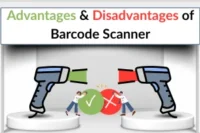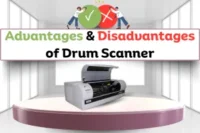Advantages and Disadvantages of Line Printer – Simple Guide for Beginners
Published: 8 May 2025

Hey Champs!
Have you ever seen big offices or banks print thousands of pages quickly? Before modern printers, line printers were the main choice for printing huge reports like exam results and bank statements.
In this article, we’ll explore the advantages and disadvantages of line printers simply so you can understand why they were useful—and why they are rarely used today.
| What is a Line Printer? (Brief Overview for Students & Beginners) |
|---|
|
A line printer is a type of printer that prints entire lines of text at once rather than individual characters. This makes it much faster than older printers that print one character at a time. There are mainly two types of line printers: Chain Printer: This uses a rotating chain of characters to print lines. Drum Printer: This cylindrical drum is covered with characters that rotate to form each line of text. Line printers were mainly used in places where large printing volumes were required, such as banks, universities, and business offices. |
Top 10 Advantages of Line Printers
Line printers were widely used for their speed and efficiency. Let’s explore the 10 most important advantages that made them popular for bulk printing tasks.
Here is quick list of benefits of lines printers:
- High-Speed Printing
- Cost-Effective for Bulk Printing
- Reliable for Large Reports
- Long-Lasting Hardware
- Minimal Software Dependency
- No Special Paper Needed
- Low Operational Costs
- Durable and Easy to Maintain
- Fixed-Format Printing
- Simple Technology
Let me walk you these above pros of line printers in simple words one by one.
1. High-Speed Printing
Line printers can print up to 3,000 lines per minute, making them ideal for large-scale printing like financial reports and university exam results.
2. Cost-Effective for Bulk Jobs
They offer a low printing cost per page, perfect for businesses or organizations with high-volume printing needs.
3. Reliable for Large Reports
Line printers are highly reliable when printing large volumes like bank statements, invoices, and detailed reports.
4. Long-Lasting Hardware
These printers were built to last. With regular care, they worked for many years without needing replacement.
5. Minimal Software Dependency
Unlike modern printers, line printers require less configuration and fewer software setups, making them easier to use in environments with limited technical support.
6. No Special Paper Required
Line printers can print on continuous paper rolls, reducing the cost of paper and increasing printing efficiency.
7. Low Operational Cost in Long Term
After setup, running them was cheap. They didn’t need costly ink cartridges or parts like modern printers.
8. Durable and Easy to Maintain
These printers are rugged and can withstand wear and tear. Maintenance is easy and doesn’t require expensive replacements.
9. Fixed-Format Printing
Line printers are ideal for printing documents with fixed layouts, such as serial numbers, records, and large forms. They maintain precision and consistency.
10. Simple Technology
The technology behind line printers was simple. Even people with basic computer knowledge could operate them easily.

Top 10 Disadvantages of Line Printers
Even though line printers had many benefits, they also had some drawbacks. In this section, we’ll look at the top disadvantages that made people stop using them over time.
Here is quick list of limitations of line printer:
- Very Noisy Operation
- Limited to Text-Only Printing
- Bulky and Heavy
- Limited Font Options
- Requires Continuous Paper
- Slow for Small Print Jobs
- Expensive Initial Cost
- Mechanical Parts Wear Out Quickly
- Not Suitable for Modern Printing Needs
- Outdated Technology
Let me explain these downsides in simple terms.
1. Very Noisy Operation
Line printers make a loud clattering sound while printing. This noise can disturb people working nearby, especially in quiet office spaces.
2. Limited to Text Output
They can only print plain text. Line printers cannot print images, colors, or detailed graphics like modern printers.
3. Bulky and Heavy
These printers are big in size and very heavy. They take up a lot of space and are hard to move around.
4. Limited Font Options
Line printers support only basic fonts. You can’t use stylish or creative fonts, which limits design and formatting.
5. Requires Continuous Paper
They use long rolls of continuous paper. This paper is harder to manage compared to regular cut sheets used in modern printers.
6. Slow for Small Print Jobs
Although fast for large printing tasks, line printers are not ideal for small jobs. They take time to start and stop, which can slow things down.
7. Expensive Initial Cost
Buying a line printer costs more than some modern printers. For small offices or schools, this can be a big expense.
8. Mechanical Parts Wear Out Quickly
Line printers have moving parts that wear out with time. They need regular servicing, which increases maintenance costs.
9. Not Suitable for Modern Needs
They can’t handle color prints, charts, or photos. In today’s world, most people need more advanced features for school, work, or business.
10. Outdated Technology
Line printers have been replaced by advanced technology such as laser and inkjet printers. These newer printers offer better quality, more features, and are easier to use.
Are Line Printers Still in Use Today?
Line printers were once very popular for fast and bulk printing. But today, most people and offices use laser or inkjet printers because they are faster, quieter, and give better print quality.
Still, line printers are not fully gone. You may find them in:
- Large factories or print shops
- Old government systems
- Places where very large reports are printed daily
These printers are still used there because they are fast and can handle thousands of pages at once.
In short: Line printers are not common anymore, but they are still used in some special places for bulk printing tasks.
Key Takeaways / Quick Summary
Most Common Advantages of Line Printers:
- High-speed printing: Line printers can print up to 3,000 lines per minute, making them incredibly fast for bulk printing tasks.
- Cost-effective for large jobs: With a low cost per page, they are ideal for high-volume printing in industries like banking and education.
- Reliable for large reports: They are perfect for printing large batches of text-heavy documents, like bank statements and exam results.
- Durable hardware: Their mechanical design ensures long-lasting performance, often outliving some modern printers.
Main Disadvantages of Line Printers:
- Noisy operation: Line printers’ loud sounds can be disruptive, making them less suitable for modern office environments.
- Limited to text output: They cannot print images or color graphics, limiting their use for more creative tasks.
- Bulky and heavy: Line printers take up a lot of space and are difficult to move, making them less practical for today’s compact office setups.
- Outdated technology: With advancements in laser and inkjet printers, line printers are increasingly being replaced by more versatile and efficient options.
Why Knowing These Helps in Understanding Printer Technology:
Knowing the advantages and disadvantages of line printers helps you understand how printers have improved over time. It shows why modern printers like inkjet and laser are now more common. They offer better features, are quieter, and fit today’s printing needs.
Conclusion
So champs, I’m wrapping up this topic on the advantages and disadvantages of line printers. In short, line printers were once popular because they printed fast and handled large print jobs efficiently. However, their loud noise and limited features made them less useful in today’s world. Still, they played an important role in the history of printing.
By learning the pros and cons of line printers, beginners can better understand how modern printers have improved over time.
If you still have any questions in your mind, feel free to ask in the comment section. I’m here to help you!
FAQs – People Also Ask
Here are some frequently asked questions by students about line printers.
Line printers are used to print large volumes of text quickly. They are ideal for jobs like printing reports, bank statements, and exam results, where speed and efficiency are required.
Line printers can print up to 3000 lines per minute, making them incredibly fast compared to many other types of printers. This high-speed capability makes them perfect for bulk printing tasks in large organizations.
Line printers use mechanical hammers to strike the paper, which causes a loud noise during printing. This noisy operation can be disruptive, especially in office environments, making them less desirable today.
No, line printers are limited to printing text. They cannot handle complex images or color graphics. They are primarily designed for printing documents that require fixed text formatting.
A line printer prints one line of text at a time, while a page printer prints one entire page simultaneously. Line printers are faster for bulk printing but have limitations in quality and flexibility compared to page printers like laser printers.
While line printers are rare in modern offices, they can still be found in specific industries, such as large print shops or older organizations with legacy systems. However, most businesses have switched to more versatile printers, such as laser and inkjet printers.
Line printers are durable and can last many years with proper maintenance. Their mechanical design allows them to withstand heavy usage, making them a long-term investment.
Line printers typically use continuous paper rolls rather than regular sheets of paper. This type of paper is more efficient for high-volume printing but is less convenient than cut sheets of paper used by modern printers.
The main disadvantages include being noisy, bulky, and limited to text-only output. They also require continuous paper and are slow for smaller, on-demand print jobs, making them less suitable for today’s diverse printing needs.
Yes, line printers are relatively easy to maintain, thanks to their simple mechanical design. They don’t require complex software; maintenance typically involves regular cleaning and replacing worn-out parts.

- Be Respectful
- Stay Relevant
- Stay Positive
- True Feedback
- Encourage Discussion
- Avoid Spamming
- No Fake News
- Don't Copy-Paste
- No Personal Attacks

- Be Respectful
- Stay Relevant
- Stay Positive
- True Feedback
- Encourage Discussion
- Avoid Spamming
- No Fake News
- Don't Copy-Paste
- No Personal Attacks



